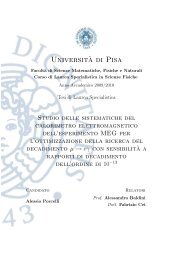Metodi di calibrazione e ricostruzione degli eventi nell ... - MEG
Metodi di calibrazione e ricostruzione degli eventi nell ... - MEG
Metodi di calibrazione e ricostruzione degli eventi nell ... - MEG
You also want an ePaper? Increase the reach of your titles
YUMPU automatically turns print PDFs into web optimized ePapers that Google loves.
1.4 Il deca<strong>di</strong>mento µ + → e + γ 15<br />
Rµ dei fasci impiegati (espressa in Hz) e le risoluzioni “larghezza a metà altezza” (in inglese<br />
“Full Width Half Maximum”, FWHM) sulle variabili cinematiche Ee, Eγ, teγ, θeγ ottenute nei<br />
vari esperimenti sono mostrate in tabella 1.5 e confrontate con quanto atteso per <strong>MEG</strong> (ultima<br />
riga) 4 . L’illustrazione grafica dell’evoluzione temporale del limite su BR (µ→eγ) è mostrata in<br />
figura 1.9.<br />
Esperimento Anno Rµ (s −1 ) ∆Ee ∆Eγ ∆teγ ∆θeγ Duty Cycle Limite (90%C.L.) Ref.<br />
TRIUMF 1977 2 × 10 5 10% 8.7% 6.7ns - 100% < 3.6 × 10 −9 [34]<br />
SIN 1980 5 × 10 5 8.7% 9.3% 1.4ns - 100% < 1.0 × 10 −9 [35]<br />
LANL 1982 2.4 × 10 6 8.8% 8.0% 1.9ns 37mrad 6.4% < 1.7 × 10 −10 [36]<br />
Crystal Box 1988 3 × 10 5 8.0% 8.0% 1.8ns 87mrad (6..9)% < 4.9 × 10 −11 [37]<br />
<strong>MEG</strong>A 1999 1.5 × 10 7 1.2% 4.5% 1.6ns 15mrad (6..7)% < 1.2 × 10 −11 [29, 30]<br />
<strong>MEG</strong> 2010 3 × 10 7 0.7 ÷ 0.9% 4% 0.15ns 18mrad 100% < 1 × 10 −13 [38]<br />
Tabella 1.5: Evoluzione del limite per il BR del processo µ + → e + γ<br />
L’esame <strong>di</strong> questa tabella mostra che, grazie all’elevata intensità del fascio utilizzato e alle<br />
risoluzioni che si prefigge <strong>di</strong> raggiungere, l’esperimento <strong>MEG</strong> potrà migliorare l’attuale limite<br />
sul rapporto <strong>di</strong> deca<strong>di</strong>mento del processo µ + → e + γ <strong>di</strong> circa due or<strong>di</strong>ni <strong>di</strong> grandezza [38].<br />
Figura 1.9: Evoluzione nel tempo del limite al 90% <strong>di</strong> C.L. sul B.R. per il processo µ + → e + γ<br />
1.4.2 Segnatura del deca<strong>di</strong>mento e fon<strong>di</strong><br />
La segnatura del deca<strong>di</strong>mento µ + → e + γ (mµ ≈ 105.66 MeV [2]) con µ a riposo è data dalla<br />
coincidenza <strong>di</strong> un positrone ed un fotone, emessi simultaneamente con un angolo relativo <strong>di</strong><br />
180 ◦ ed un’energia <strong>di</strong> circa 52.83 MeV ciascuno, come illustrato in fig. 1.10. I fon<strong>di</strong> presenti<br />
<strong>nell</strong>’esperimento sono principalmente due:<br />
1. il fondo “fisico” (o “correlato”);<br />
2. il fondo “accidentale”, dovuto a coincidenze casuali tra positroni e fotoni all’interno della<br />
finestra temporale ∆teγ <strong>di</strong> sensibilità dell’esperimento.<br />
4 D’ora in poi in<strong>di</strong>cheremo con ∆x la risoluzione sperimentale FWHM della variabile x; analogamente per le<br />
altre. In<strong>di</strong>cheremo invece con δx la semi-larghezza della finestra <strong>di</strong> ricerca del segnale per la variabile x. Ad es.<br />
per una variabile x con <strong>di</strong>stribuzione gaussiana si può definire una finestra <strong>di</strong> ricerca con probabilità del 90% <strong>di</strong><br />
trovare il segnale. La larghezza <strong>di</strong> questa finestra è 1.4 · ∆x, da cui δx = 0.7 · ∆x



